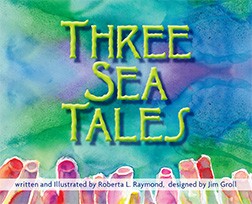“Three Sea Tales”
- Share
- Tweet
- Pin
- Share

“Three Sea Tales” by Roberta L. Raymond.
Written and illustrated by Roberta L. Raymond
This is a wonderful book for children of all ages. The three stories reveal another world – the world under the sea where even fish work together.
Based on Raymond’s observations while snorkeling, the stories inform as well as entertain. Short “author’s notes” at the end of each story bring a personal note to the fictionalized, yet factual, tale the reader just completed.
Raymond, aka Bobbie Larson, is primarily know as an artist and her beautiful, transparent watercolors bring her stories to life. Gus, Frenchy and Sylvie are depicted as they appeared to Raymond during her underwater observations – no animation here!
The stories are fun but most of all intriguing. “Gus the Flying Gurnard” has wings – who knew that fish had wings? Fins, yes! But wings? And multicolored wings at that!
The idea of a fish cleaning station manned by a juvenile angelfish seems like fiction, but it’s real and is relayed in “Frenchy’s Cleaning Station,” the second part of Raymond’s book.
I am especially fond of Frenchy because Raymond shared this story with me several years ago when she first wrote the story. I tend to be picky when it comes to books for children so I was skeptical. But I was delighted when the story turned out to be a well-written, informative tale with a genuinely unique subject matter.
I field tested “Frenchy’s Cleaning Station” with a classroom of third graders (a tough sell, as most elementary teachers will confirm) and was delighted by their enthusiasm and insight into the stories. When I shared their reaction with Raymond, she summoned the courage to meet with them to read the story. She left smiling, certain that she had a story worth publishing.
In part three, the reader learns that squids actually change colors. Imagine how Sylvie, the squid at the center of the story, feels when she tries to change colors and fails.
In “Sylvie – The Squid Who Couldn’t Change Colors” Sylvie’s anguish over being different is something every reader can relate to. Raymond tells the story realistically but with empathy, and eventually Sylvie learns that patience pays off.
Read this book aloud to those too young to read for themselves and give copies to those who can read on their own. Raymond respects her readers and her descriptive prose illuminates the beautiful watercolors that accompany and enhance the text.
Raymond has written and illustrated a fine book and one worthy of being added to the list of classic children’s picture books.

